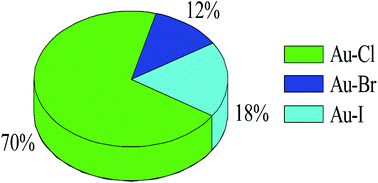How do organic gold compounds and organic halogen molecules interact? Comparison with hydrogen bonds†
Abstract
An Au⋯X interaction has been predicted in the complexes between the organic gold compound RAu (R = CH3, C2H3, and C2H) and the organic halogen compound R′X (R′ = CH3, C2H, C2H3, and CF3; X = Cl, Br, and I) using quantum chemical calculations. Upon the basis of the anisotropic distribution of molecular electrostatic potentials on the Au and X atoms, two types of structures, represented as GB and XB, respectively, were obtained. In the GB structure, the Au atom acts as a Lewis acid and X is a Lewis base, but reversed roles are found for Au and X in XB. Interestingly, the former structure is far more stable than the latter one. Their difference in stability can be regulated by the substitution and hybridization effects, similarly to those in hydrogen bonds. The partially covalent-interaction nature of GBs was characterized with the large charge transfer and the negative energy density as well as the high interaction energy. GB interaction is dominated by electrostatic and polarization energies, whereas electrostatic and dispersion energies are responsible for the stability of most XB complexes. This is an interesting finding that both patterns of interactions are different in nature even though the two monomers are only different in the spatial orientation for both interactions.


 Please wait while we load your content...
Please wait while we load your content...